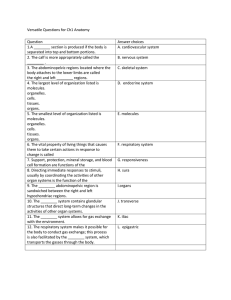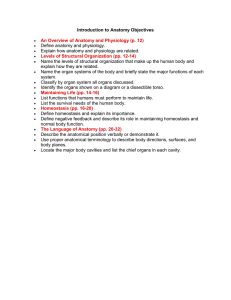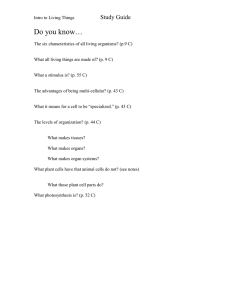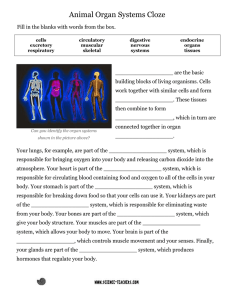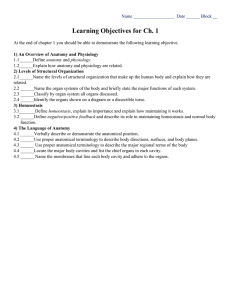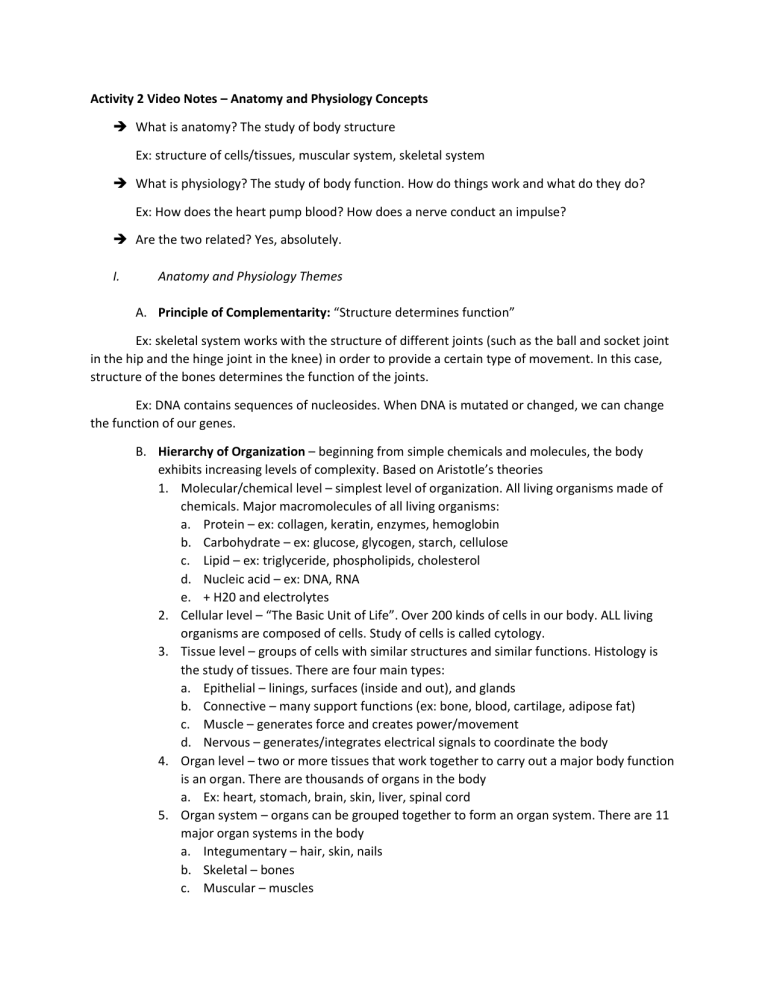
Activity 2 Video Notes – Anatomy and Physiology Concepts What is anatomy? The study of body structure Ex: structure of cells/tissues, muscular system, skeletal system What is physiology? The study of body function. How do things work and what do they do? Ex: How does the heart pump blood? How does a nerve conduct an impulse? Are the two related? Yes, absolutely. I. Anatomy and Physiology Themes A. Principle of Complementarity: “Structure determines function” Ex: skeletal system works with the structure of different joints (such as the ball and socket joint in the hip and the hinge joint in the knee) in order to provide a certain type of movement. In this case, structure of the bones determines the function of the joints. Ex: DNA contains sequences of nucleosides. When DNA is mutated or changed, we can change the function of our genes. B. Hierarchy of Organization – beginning from simple chemicals and molecules, the body exhibits increasing levels of complexity. Based on Aristotle’s theories 1. Molecular/chemical level – simplest level of organization. All living organisms made of chemicals. Major macromolecules of all living organisms: a. Protein – ex: collagen, keratin, enzymes, hemoglobin b. Carbohydrate – ex: glucose, glycogen, starch, cellulose c. Lipid – ex: triglyceride, phospholipids, cholesterol d. Nucleic acid – ex: DNA, RNA e. + H20 and electrolytes 2. Cellular level – “The Basic Unit of Life”. Over 200 kinds of cells in our body. ALL living organisms are composed of cells. Study of cells is called cytology. 3. Tissue level – groups of cells with similar structures and similar functions. Histology is the study of tissues. There are four main types: a. Epithelial – linings, surfaces (inside and out), and glands b. Connective – many support functions (ex: bone, blood, cartilage, adipose fat) c. Muscle – generates force and creates power/movement d. Nervous – generates/integrates electrical signals to coordinate the body 4. Organ level – two or more tissues that work together to carry out a major body function is an organ. There are thousands of organs in the body a. Ex: heart, stomach, brain, skin, liver, spinal cord 5. Organ system – organs can be grouped together to form an organ system. There are 11 major organ systems in the body a. Integumentary – hair, skin, nails b. Skeletal – bones c. Muscular – muscles d. Nervous system – brain, spinal cord, nerves e. Endocrine – hormones f. Cardiovascular – heart, blood vessels g. Lymphatic – drains body fluids, immune system h. Respiratory i. Digestive j. Urinary k. Reproductive 6. Organism – highest level of organization. Sum of all organ systems working together II. How do we define “life”? A. How can you tell if something is “living”? What are the characteristics of life? What are necessary life properties? 1. Cellular composition – must be made of cells 2. High levels of organization 3. Responsiveness/movement – self-directed movement 4. Growth/reproduction – new cells are produced 5. Metabolism and Homeostasis B. Metabolism – the sum of all chemical reactions in an organism. There are two ways to classify metabolism: - Catabolism – large molecules (proteins, complex carbs, lipids, nucleic acids) are broken down into smaller molecules. Releases energy in the process Ex: the food we eat is digested (broken down) into smaller molecules by a catabolic reaction. Energy is either stored away or it can be used later on. Flow of energy is directed by the cells. - Anabolism – small molecules (amino acids, monosaccharides, etc) built up into larger molecules. C. Homeostasis – the ability of an organism to maintain a relatively stable internal environment. Based on Hippocrate’s idea of maintaining balance in the body. Many internal conditions are attributed to homeostasis - Ex: blood Ph, oxygen level, blood pressure level, body temperature - Negative feedback regulation – the response opposes the original stimulus. Most negative feedback is an ongoing process, so the body can constantly be monitored in order to maintain balance. Ex: if body temp is too high, a signal will be sent to effector organs. Brain is the control center that monitors changes. The brain sends signals to sweat glands to activate in order to produce a response and cool your body down. Also happens when body temp is too low, the brain sends out signals to sweat glands to constrict and muscles to contract (shiver) to preserve body heat - Positive feedback – the response enhances the original stimulus. Finishes a process that has already begun. “snowball effect” Ex: labor contractions. Baby puts pressure on the cervix and the cervix responds by transmitting nerve impulses to the brain. The brain then starts to secrete oxytocin, which is carried through the bloodstream to the uterus. Oxytocin then stimulates uterus contractions further to push the fetus toward the cervix. The positive feedback (contractions) is enhanced until the baby is born POWERPOINT REVIEW: Powerpoint Review: 1. How are anatomy and physiology of the body related? 2. What is the simplest level of body organization, and what is the "basic unit of life"? 3. How are cells, tissues and organs related to each other in the hierarchy of body organization? 4. What characteristics of life are truly essential to defining "life"? 5. How is negative feedback different from positive feedback in a homeostatic regulation?



